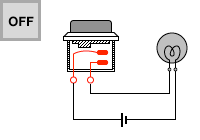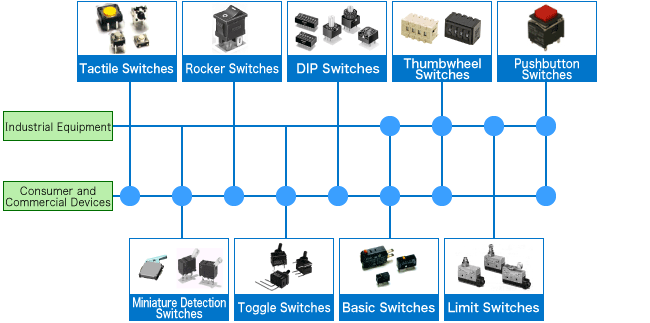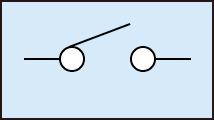What is an Electrical Switch?
Switch Definition
A switch responds to an external force to mechanically change an electric signal. Switches are used to turn electric circuits ON and OFF and to switch electric circuits.
1. Circuit ON/OFF Operation

The contacts are separated while the switch is not pressed, so the circuit is not connected and the lamp is not lit.

When the switch is pressed, the contacts come into contact, closing the circuit and lighting the lamp.
2. Circuit Switching Operation

While the switch is not operated, the lamp on circuit L1 is lit.

When the switch is pressed, the circuit is switched so that the lamp on circuit L2 is lit.
Switch Types & Classifications
1. Types of Switches
There are many different types of switches. Based on their size, robustness, environmental resistance and other characteristics, they are divided into switches for industrial equipment and switches for consumer and commercial devices.

2. Switch Classifications

Contact Form
1. SPST-NO (Single Pole Single Throw Normally Open)
The contacts close when the switch is operated. They are normally open.

The contacts are separated while the switch is not pressed, so the circuit is not connected and the lamp is not lit.

When the switch is pressed, the contacts come into contact, closing the circuit and lighting the lamp.
Use NO contacts when you want the load to operate when the switch is operated.
2. SPST-NC (Single Pole Single Throw Normally Closed)
The contacts open when the switch is operated. They are normally closed.


While the switch is not pressed, the circuit is connected and the lamp is lit.
When the switch is pressed, the contacts separate, opening the circuit and causing the lamp to go out.
Use NC contacts when you want the load to stop operating when the switch is operated.
3. SPDT (Single Pole Double Throw)
Changeover contacts have the functions of the both NO and NC contacts.

Use changeover contacts when you want to switch two circuits when the switch is operated.
Switches in Electrical Circuits: Pole & Throw
“Pole” indicates the number of circuits that one switch can control for one operation of the switch. “Throw” indicates the number of contact points. NO and NC contacts are single throw. Changeover contacts are double throw.
If one switch can control one circuit for one operation, it is a single-pole switch. If it can control two or three circuits for one operation, it is a double-pole or a triple-pole switch.
| Single-pole, Single-throw |
The switch contains one circuit with NO or NC contacts. |  |
|---|---|---|
| Single-pole, Double-throw |
The switch contains one circuit with changeover contacts. |  |
| Double-pole, Single-throw |
The switch contains two circuits with NO or NC contacts. |  |
| Double-pole, Double-throw |
The switch contains two circuits with changeover contacts. |  |
Use a multipole switch when you want to control more than one circuit at the same time.
Manual Switch Operation
There are two operation patterns for Manual Switches: Momentary Operation and Alternate Operation
For a momentary operation, the switch stays ON only while it is being pressed.
For alternate operation, the ON state is held after the switch is released. The switch turns OFF when the switch is pressed again.

1. Momentary Operation
The switch is ON only while it is pressed. The switch turns OFF when it is released. For example, in crane games, the crane moves only while the switch is being pressed.

2. Alternate Operation
After you press the switch, the ON state is held even when the switch is released. To turn OFF the switch, you must press it again.
For example, the power switch on a TV uses alternate operation.
Alternate switches are used to maintain the ON state for a long period of time, such as for main power switches.
Switch Loads
The load is the device that the switch turns ON and OFF.
The load is connected to an electric circuit and it consumes electric energy.
Loads are divided into inductive loads and non-inductive loads.
An inductive load contains a coil, such as a motor.
Non-inductive loads are divided into lamp loads and resistive loads.

You must select a suitable switch for the load that will be used.

